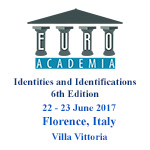Euroacademia Conferences
 Europe Inside-Out: Europe and Europeanness Exposed to Plural Observers (9th Edition) April 24 - 25, 2020
Europe Inside-Out: Europe and Europeanness Exposed to Plural Observers (9th Edition) April 24 - 25, 2020 Identities and Identifications: Politicized Uses of Collective Identities (9th Edition) June 12 - 13, 2020
Identities and Identifications: Politicized Uses of Collective Identities (9th Edition) June 12 - 13, 2020 8th Forum of Critical Studies: Asking Big Questions Again January 24 - 25, 2020
8th Forum of Critical Studies: Asking Big Questions Again January 24 - 25, 2020 Re-Inventing Eastern Europe (7th Edition) December 13 - 14, 2019
Re-Inventing Eastern Europe (7th Edition) December 13 - 14, 2019 The European Union and the Politicization of Europe (8th Edition) October 25 - 26, 2019
The European Union and the Politicization of Europe (8th Edition) October 25 - 26, 2019 Identities and Identifications: Politicized Uses of Collective Identities (8th Edition) June 28 - 29, 2019
Identities and Identifications: Politicized Uses of Collective Identities (8th Edition) June 28 - 29, 2019 The European Union and the Politicization of Europe (7th Edition) January 25 - 26, 2019
The European Union and the Politicization of Europe (7th Edition) January 25 - 26, 2019 7th Forum of Critical Studies: Asking Big Questions Again November 23 - 24, 2018
7th Forum of Critical Studies: Asking Big Questions Again November 23 - 24, 2018 Europe Inside-Out: Europe and Europeanness Exposed to Plural Observers (8th Edition) September 28 - 30, 2018
Europe Inside-Out: Europe and Europeanness Exposed to Plural Observers (8th Edition) September 28 - 30, 2018 Identities and Identifications: Politicized Uses of Collective Identities (7th Edition) June 14 - 15, 2018
Identities and Identifications: Politicized Uses of Collective Identities (7th Edition) June 14 - 15, 2018
‘And Perhaps, in the Corner, a Lubra’ How the Exhibition An Englishman’s Home Sought to Define an Australian Identity
-
-

-
Presentation speakers
- Victoria Souliman, Université Paris 7, France / University of Sydney, Australia
Abstract:
As Richard White explains in Inventing Australia, a “national identity is continually being fractured, questioned and redefined.” During the interwar years, a new national consciousness emerged in response to Australia’s war effort and proud imperial loyalty. This new perspective questioned Australia’s identity and, in particular, its relationship with Britain. On an artistic level, Australian artists in the 1920s and 1930s re-envisaged Australia as a modern, grown‐up and independent nation that had broken away from British cultural influence, thereby contributing to the making of a new image of Australian identity. This idea was recently addressed through the exhibition Sydney Modern: Art for a New World (2013) held at the Art Gallery of New South Wales. Most importantly, the exhibition shed light on the central role of interior design and exhibitions of decorative art, more specifically the Burdekin House Exhibition (1929), in developing ideas about Australian taste, identity and culture at the time. Focusing on the case study of the exhibition An Englishman’s Home organised by Clarice Zander and held in Sydney in 1941, this paper will consider how this exhibition explored notions of an Australian past and cultural heritage in order to define its national identity. The aim of this paper is to demonstrate how Zander’s 1941 exhibition can be construed not only as a vehicle for modern taste, but also as a primary means of defining Australia’s national identity, more particularly within the frame of its identification with Britain. This paper addresses Australia’s cultural ties with Britain, modernism, the role of exhibitions, the decorative arts and national identity.
-
Related Presentations

Only of Local Significance? The German Artist Otto Hettner (1875-1931) between Dresden and Europe
- Kati Renner













